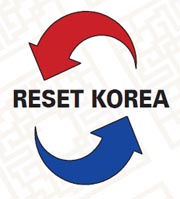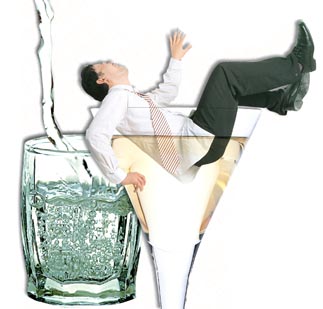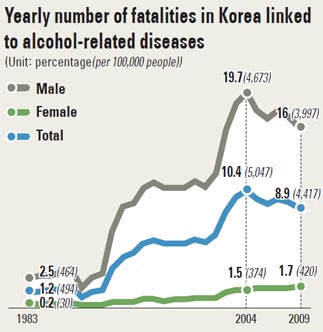bottoms up?
Corporate Korea distorts historic drinking culture

“My immediate boss commented snidely that I would someday regret refusing the alcohol,” said the 24-year-old, who got a job at a local finance company a year ago. She asked that her full name not be disclosed.
“What really got to me though was that all my co-workers at that restaurant sat there in dead silence, like mindless robots,” she said.
Choi ended up drinking the shot of soju and got a small allergic rash the next day. Even after her compromise, however, her boss often makes fun of her about being “high maintenance.” She said that she still couldn’t shake the feeling that refusing the soju has hurt her career at the company.
Lee’s story isn’t a unique one in Korea, where a modern corporate culture has somewhat distorted the country’s traditional, etiquette-based drinking culture that stems from its Confucian influences.
A typical hoesik, or company outing, in Korea starts at a grilled meat restaurant, where work colleagues wash down their food with soju. Afterward, the group usually goes to icha (a second round), oftentimes a bar. Samcha (third round) usually involves a Korean karaoke bar, where boilermakers of whiskey and beer are offered. Those who survive the third round go onto a fourth round, which often involves haejangguk, or hangover soup, accompanied by more beer or soju. The aim is to push their limits in order to bond with co-workers and form “team spirit.”
Korea’s corporate culture is so dependent on alcohol that according to the Korean Alcohol Research Foundation - the country’s foremost authority on drinking culture - more than 90 percent of company outings revolve around booze.
Three out of 10 workers said they were dependent on alcohol to succeed at the workplace, according to a recent survey by Incruit, one of the biggest online job recruiting agencies in Korea. It added that one out of 10 workers in the survey of 684 male and female workers thought they needed counseling due to an “addictive” reliance on alcohol.
Ugly side effect of corporate life

Michelle Farnsworth, an American who has lived in Korea since 2002, said it was the pressure to prove she is “one of us [Korean]” by drinking that has puzzled her. When working at a local beef import company, Farnsworth recalled that she had to attend a hoesik on the 30th of every month.
“I like drinking, but it’s not fun when you are not drinking at your pace. And because of the peer pressure here to drink, you just can’t say no,” the 31-year-old said. “What’s different from my culture is that back home, you never want to drink with your boss, let alone drink out of their glass.”
In her new job as a foreign client manager at a local bank, she tells colleagues she doesn’t drink when out at hoesik.
Korean managers using their position of power to force underlings to drink has emerged as a major social problem.
In 2007, the Seoul High Court ruled that a manager at an online game company had to pay $32,000 to one of his subordinates for forcing her to drink alcohol during a hoesik - the first ruling of its kind. The court said that the manager violated his subordinate’s human dignity and said that forcing her to drink alcohol was illegal.
An Irish man who heads the Korean branch of a global industrial company described Korea’s drinking culture as “almost savage.”
“In Ireland, I would be able to go to a pub, stay there for four hours and go home not being drunk at all, but in Korea, that is impossible,” he said, declining to be named. “Forcing drinks on people and pushing glasses into their hands, and this being the norm, is quite shocking for a foreigner like myself.”
A historical connection

Kim explained that along with sujak, the tradition of guneum, or drinking in groups, is unique to Korea, stemming from before the Three Kingdoms period (57 B.C.-676).
One theory of guneum’s origins points to the country’s agricultural roots. “Unlike neighboring countries like Thailand or Indonesia where you can grow anything at anytime of the year, in Korea, we had to plant and harvest only at certain times of the year. Because of time constraints, farmers tended to work together in groups to get the most yield during harvest season,” said Lee Jong-ki, head of Liquorium, a liquor museum in Chungju, North Chungcheong.
Lee, also a food engineering professor at Hankyong National University, explained that farmers tended to enjoy their leisure time together as well.
The Joseon Dynasty (1392-1897) is often cited as the golden age for Korean liquor. Documents and literature from the period show that there were around 340 varieties of Korean liquor. “Even as the drinking culture flourished at this time, there was a strict set of manners required for drinking, including holding up your glass with two hands and turning away from your elder when taking a sip,” said Kim.
“These respectable traditions are still prevalent today, but more on a shallow, surface level, without thought on what these manners really represent,” he added.
A changing drinking culture
Japanese colonial rule (1910-1945) altered Korea in many ways, and the country’s drinking culture was no exception.
A liquor tax law in 1916 effectively banned the making of any Korean liquor in households as well as outlawing Korean-style taverns.
The decline of the traditional drinking culture was further accelerated when, in 1965, an agriculture protection law prohibited the use of rice in making alcoholic beverages. Production of high-quality, distilled liquor - as opposed to liquor made by diluting ingredients - like Andong soju became illegal.
Professor Lee said it was right after this time, during the 1970s, when imports of Western liquor, including whiskey and beer, skyrocketed. The trend is still going strong today. According to data from the Fair Trade Commission, the best-selling alcoholic drink in Korea is beer, making up 46.3 percent of the alcohol market. Traditional liquor took up less than 1 percent.
The Korea Alcohol and Liquor Industry Association reported that Korea imported $3.84 million of whiskey, wine and beer in 2009 and that, including domestic liquor, the country was the world’s ninth-biggest market for whiskey.
“During the 1970s and 1980s, Korea’s industrialization took off, during which the drinking culture we know today began to take form, centering around large conglomerates like Samsung, Daewoo and Hyundai,” he said.
“In order to form strong group solidarity and show commitment to one’s company, the old traditions of sujak and guneum evolved into a peculiar drinking culture here involving boilermakers and group binge drinking. It was a fast, easy way to bond.”
Binge drinking is the problem
On the whole, Koreans consume slightly below the average amount of alcohol per person, compared to countries belonging to the Organization for Economic Cooperation and Development.
According to the most recent OECD report on alcohol consumption, the average Korean drank around 8 liters of pure alcohol in 2007, compared to the OECD average of 9.7 liters per head. This is in contrast to the 13 liter average in France, 11.2 liters in the United Kingdom and 8.6 for the United States.
But the real problem for Koreans’ drinking habits, according to local experts, lies in binge drinking, which medical experts stress can be fatal.
“Modern day Koreans like to drink a lot, all at once. Especially in company settings, they drink to get drunk together, instead of enjoying the drinks, which is totally different from how our ancestors drank,” said Lee Sang-hee, former minister of home affairs and author of a series of books titled “Korea’s Drinking Culture.”
Over the years, this kind of drinking habit has catapulted the number of deaths in the country from diseases related to alcohol consumption. Data from Statistics Korea show that 494 Koreans per every 100,000 died from alcohol related diseases in 1983, mainly from liver failure. By 1992, this number rose to 2,023 for every 100,000 people. By 2009, deaths doubled to 4,417 people per 100,000.
Lee Yeong-suk, a medical professor at the Catholic University of Korea, warned that the body’s ability to process alcohol varies from person to person.
Binge drinking, he said, creates a much higher risk of liver disease for those whose bodies cannot breakdown the byproducts of alcohol.
“The drinking culture here has become twisted, in that Koreans are so forgiving and lenient of binge drinking,” said Kim, from the Korean Alcohol Research Foundation. “Even if a drinking session turns into what some might call mild sexual harassment, in Korea, it is overlooked or brushed off, with a sort of ‘boys will be boys’ sentiment.”
A push for change
A handful of alcohol-related harassment cases in recent years have started to change things.
As one of the first companies to address irresponsible corporate drinking, Posco, the nation’s largest steelmaker, has been limiting employees at its Pohang mill to two hours of hoesik per outing since 2005. Since last year, local home appliance giant Woongjin Coway Co. has banned its executives from using the company card to pay for drinks with clients after 11 p.m. Kolon Industries, a Korean chemical fiber company, replaced its usual year-end hoesik and conducted a company blood donation drive instead.
During the short time Choi spent in corporate Korea, she said she had become so disillusioned that she intends to look for a new job.
“A bad hoesik culture in a company reflects its overall stance on the welfare of its employees, whether it is child care benefits for married employees or health benefits. I can’t believe that my boss is dumb enough to not see what a huge mistake it is in the end - to force drinks on his staff,” she said.
By Cho Jae-eun [jainnie@joongang.co.kr]










with the Korea JoongAng Daily
To write comments, please log in to one of the accounts.
Standards Board Policy (0/250자)